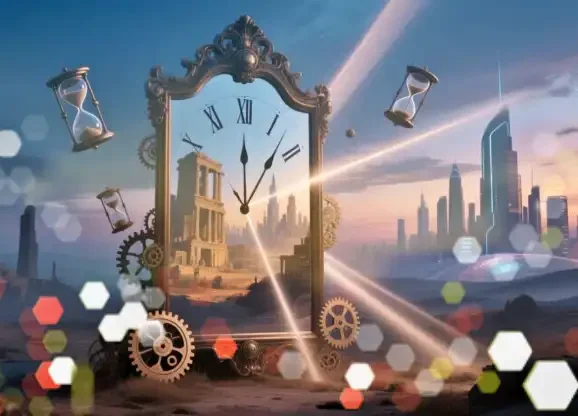Clock, Have you ever stopped to wonder why the hands on every clock spin right? It seems like an arbitrary design choice why not the other way?
This simple question, however, leads us on a fascinating journey, tracing the direction of timekeeping not to a mechanical blueprint, but to the very first clock ever conceived: the Sun Dial.
Clock, Ancient Legacy of the Northern Sun.
The standard direction of clock movement what we call clockwise is a deeply embedded historical standard, rooted in the astronomical observations of early civilizations located in the Northern Hemisphere.
The Shadow’s Dance.
Imagine standing next to a vertical stick, a rudimentary sun dial, in Ancient Egypt or Greece. As the sun rises in the east and tracks across the southern sky toward the west, the shadow cast by the stick moves.
Critically, if you look down at the dial, the shadow sweeps from left to right in the clockwise direction.
• Egyptians, Greeks, and Romans: The earliest timekeeping cultures, including these major groups, all developed their systems north of the equator.
• The Natural Standard: For these original clock-makers, the direction of the shadow’s movement was the most natural and intuitive way to mark the passage of time. It was the universe’s own pointer, dictating the standard.
From Shadow to Gear.
When mechanical clocks first emerged in medieval Europe (around the 13th to 14th centuries), particularly the massive public tower clocks, the craftsmen had a simple, logical choice: imitate the familiar.
They designed the gears and hands to mimic the trajectory of the sun dial’s shadow in the Northern Hemisphere, solidifying the clockwise motion as the universal convention we still use today.
The ephemeral sweep of a shadow across ancient sand was thus permanently etched into the mechanics of time.
What If Time’s Arrow Had Pointed Left?
This brings us to a fascinating hypothetica! What if the first great civilizations had flourished in the Southern Hemisphere?
If the Egyptian, Greek, and Roman empires had been situated south of the equator, the entire history of timekeeping would likely be reversed.
• The Southern Shadow: South of the equator, the sun tracks across the northern sky. Consequently, the shadow on a sun dial moves in the opposite direction counter-clockwise (right to left).
• An Opposite Convention: If this had been the foundation, the leftward motion would have become the intuitive “forward” direction. Today, “clockwise” would describe a movement to the left, and every mechanical clock, globe, and even the rotational direction of screws might have followed this reversed standard.
The direction of a clock’s hands, therefore, is not an inherent law of physics but a human-made invention a powerful social contract born from geography and tradition.
Beyond the Dial.
Is Time’s Arrow Reversible?
While the movement of clock hands is a fixed convention, the very nature of time’s direction the so-called “Arrow of Time” is one of modern physics’ greatest mysteries.
In our everyday experience, time is strictly linear: the past is fixed, the present fleeting, and the future unknown. But at the most fundamental levels, scientists are uncovering evidence that time might be far more flexible, even reversible, than we perceive.
The Problem of Entropy.
The reason we experience time as having a single, forward direction is largely due to the second law of thermodynamics, which defines entropy the measure of disorder in a closed system.
ΔS≥0
The equation states that entropy (S) must always increase or stay the same. In simple terms, a broken glass (high disorder/entropy) will never spontaneously reassemble itself (low disorder). This inexorable increase in disorder is what gives time its macroscopic direction.
However, many of the fundamental laws of physics, such as the famous Schrödinger Equation that governs quantum mechanics, are time-symmetric.
Mathematically, they work just as well when time (t) is swapped for negative time (−t), implying that on the level of individual particles, events could technically unfold in reverse.
Quantum Reversibility.
The Two-Way Street.
Recent research into quantum systems is actively probing this theoretical time-symmetry.
Symmetry in Open Systems.
Studies, including work by physicists at universities like Cagliari (Italy) and Surrey, suggest that in certain open quantum systems where a system interacts with its environment time-reversal symmetry may still hold.
This challenges the standard assumption that interacting with the environment (which causes decoherence and the eventual appearance of the classical “arrow” of time) completely destroys time-symmetry.
It mathematically implies that the process could go forward or backward and still be physically permissible at the quantum scale.
Temporal Mirrors.
Reflecting Waves in Time.
Breaking ground on the theoretical front, physicists have experimentally confirmed the existence of temporal mirrors a phenomenon where electromagnetic waves are effectively reversed in time.
The CUNY Experiment.
In a groundbreaking 2025 experiment at the City University of New York (CUNY) Advanced Science Research Center, researchers successfully demonstrated temporal reflection.
By rapidly and uniformly changing the properties of a specialized metamaterial (a temporal interface), they caused a passing electromagnetic wave to not just reflect in space, but to reverse its progression in time.
Implications.
While this is not a time machine, the effect causes the wave’s frequency and direction to be reversed, essentially creating a time-inverted copy of the original signal.
This technology offers radical new possibilities for wave manipulation, potentially revolutionizing communications, radar, and signal processing by allowing for the control and reversal of wave propagation in the time domain.
The Anti-Universe.
A Grand Cosmic Reversal.
On the largest scale, some cosmologists have proposed a mind-bending theory: the existence of an Anti-Universe that is a perfect mirror of our own, running backwards in time from the Big Bang.
• CPT Symmetry: This hypothesis is rooted in a fundamental principle of physics known as CPT-symmetry (Charge, Parity, and Time). This theorem states that if you simultaneously flip a particle’s Charge (C), reverse its spatial coordinates (Parity, P), and reverse its direction in Time (T), the resulting interaction must be identical.
• Cosmic Balance: If the universe must obey CPT-symmetry in its entirety, the existence of our matter-dominated, forward-in-time universe (+T) would necessitate a complementary, mirror Anti-Universe filled with antimatter, where time flows in reverse (−T).
• Explaining Dark Matter: Intriguingly, this model offers a potential solution to the mystery of Dark Matter. The theory necessitates the existence of right-handed neutrinos—particles that are currently undetectable in our universe but would interact gravitationally. The mass of these theorized neutrinos would be sufficient to account for the total amount of dark matter observed in our cosmos.
The Unstoppable March of Macroscopic Time.
Despite the mind-bending possibilities unveiled in quantum mechanics and cosmology, the macroscopic world we inhabit is governed by the overwhelming force of entropy.
The sheer improbability of all the scattered particles in a complex system spontaneously reversing their movement means the Arrow of Time that persistent march from order to disorder, from past to future remains firmly intact for us.
When you look at your watch, the hands move clockwise because an Egyptian’s shadow moved that way thousands of years ago. That direction is a historical accident, a human convention.
Yet, beneath that surface of dependable, linear motion, modern science is revealing that time itself may be a far more complex and fluid dimension, where “forward” and “backward” are merely the prevailing defaults in a universe that is fundamentally symmetric.
The clock hands may only point one way, but the underlying laws of the cosmos suggest there’s a lot more to the story of time’s direction than meets the eye.
Have a Great Day!






